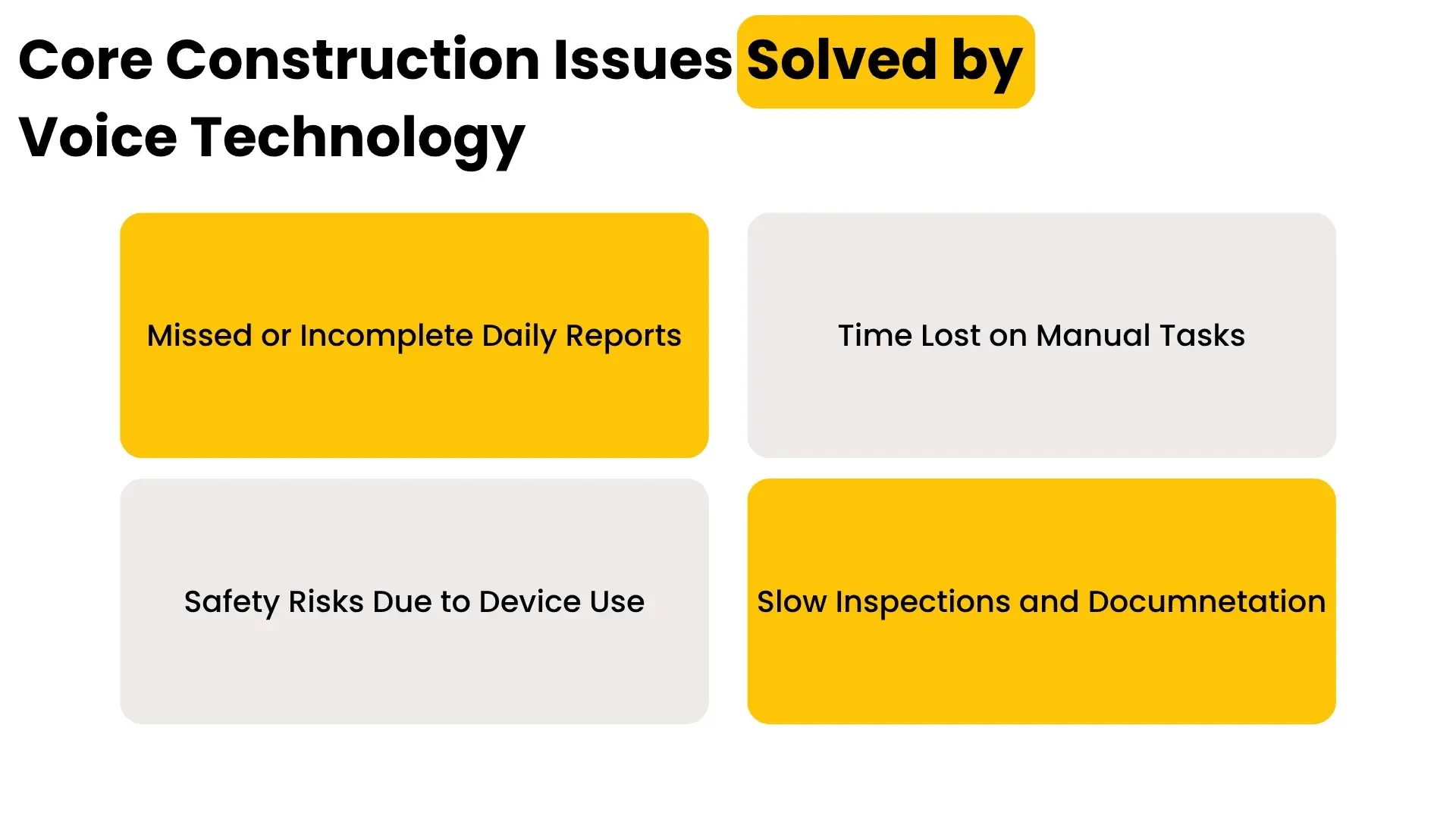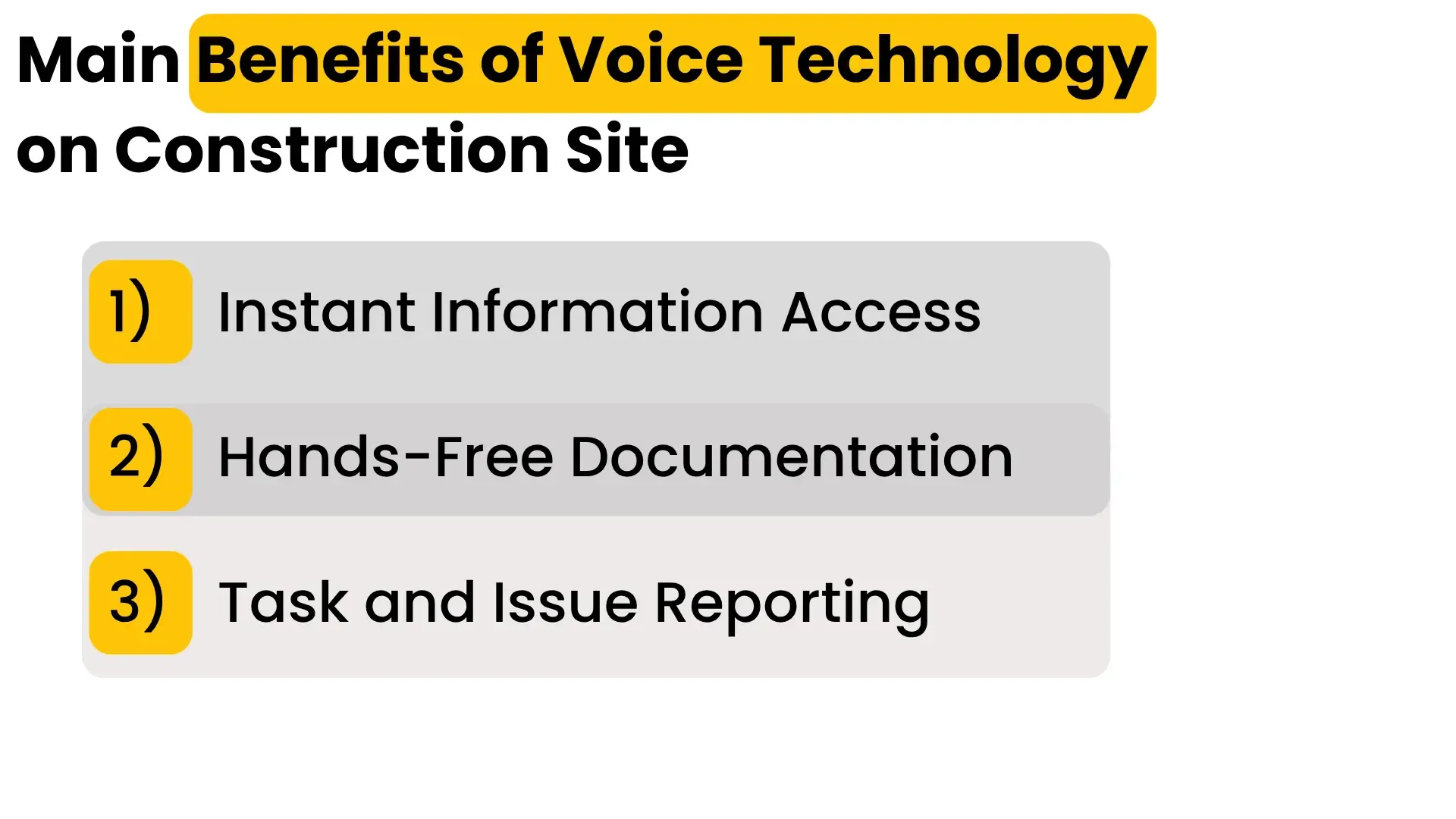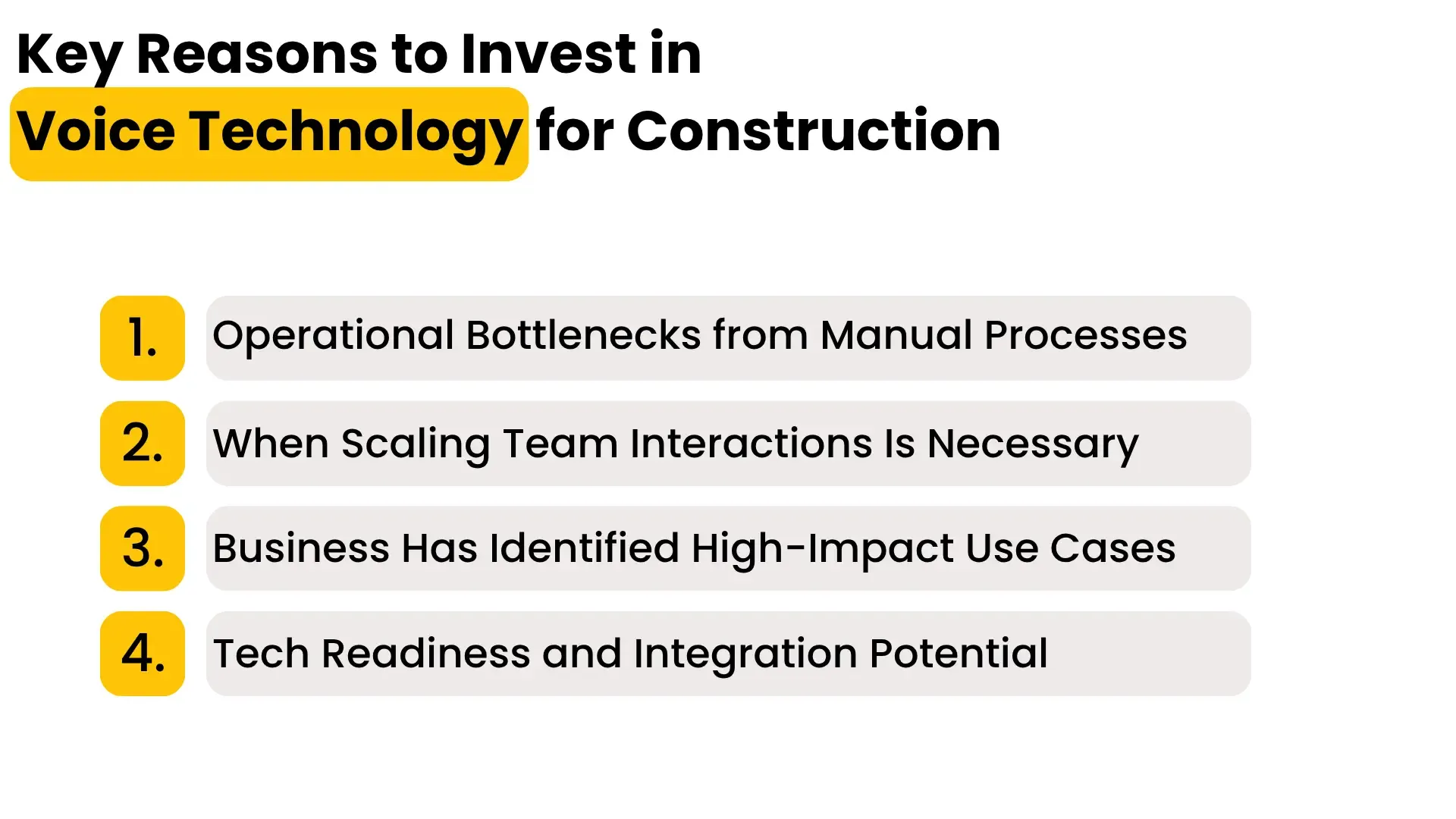Construction
Is Voice Technology Worth the Investment for Construction Firms?
August 08, 2025 • 108 Views • 16 min read
Bohdan Vasylkiv
CEO & Co-Founder
The variety of emerging technologies in construction is limitless. In fact, the construction industry is one of the most potent fields for software integration due to many factors.
At the moment, this industry manages to combine legacy systems with new-era software under one roof. The reason is simple: unlike real estate companies, construction firms were paying more attention to the functionality of integrated software, not its user-friendly designs.
As a result, many modern construction teams struggle with switching from old-fashioned, familiar platforms to modern, cluttered interfaces with numerous buttons, stats, and other UI elements, making it hard to navigate off the bat.
Fortunately, new-era features like voice technology in construction software can help to deal with such a struggle.
Key Business Problems Voice Technology Solves
Voice app development services can easily cover the UI gaps that occur when migrating from one system to another.
Unlike traditional interface-based software, voice-operated systems don’t require following strict instructions or algorithms. Let’s suppose your employees need to file reports on finished tasks or make updates in inventory management.
A traditional platform requires numerous manual interactions, including finding a related field, clicking the report button, selecting from a checklist, and then sending the report. At the same time, voice-powered construction software can perform all the steps automatically by simply listening to the employees’ commands.

On top of that, such unique features can be beneficial for workers on site, where they might lack time or opportunity to perform the same tasks right away due to safety measures or simply being busy.
The foregoing is just a single example of potential problem resolution using the voice technology in construction. Long story short, the list of key business issues that can be solved by integrating voice UIs in construction software includes:
- Missed or Incomplete Daily Reports
- Time Lost on Manual Tasks
- Safety Risks Due to Handheld Device Use
- Missed Documentation and Slow Inspections
Missed or Incomplete Daily Reports
Filing daily reports is commonly a time-consuming task that requires a lot of concentration. Traditionally, employees have to dedicate some time and effort to such tasks.
Due to numerous distractions and more pressing tasks, employees often postpone their daily reports until the end of the workday. However, this brings some risks, such as the possibility of forgetting to file a report or forgetting details. As a result, the daily reports are either missed or incomplete, making the overall management problematic.
Fortunately, smart construction technology like voice-operated systems can help to bypass these issues easily by providing your workers with more convenient ways to fill the required forms or reports. Essentially, they will require a mobile device with a logged-in account in the system or a virtual speech-to-text assistant integrated into their construction system.
Using such technologies allows workers to dictate daily logs and observations immediately as events occur, eliminating the risk of forgetting details or skipping reports at the end of the day.
On top of that, modern real-time voice-to-text solutions like Whisper or Google speech-to-text ensure entries are accurate and complete, capturing context-rich information with minimal delay and excellent transcription with none or minimal mistakes, which can be easily fixed.
Finally, it is possible to set up automated reminders and prompts from voice-enabled systems to ensure that daily documentation routines are never missed.
Time Lost on Manual Tasks
Frankly, voice-operated reports or other similar tasks are not as essential for in-office employees such as sales, marketing, or management specialists. Nevertheless, already in the near future, such functionality will become a must-have for on-site workers.
The reasons are simple: in addition to convenience and a low learning curve, voice-powered reports and updates are much more efficient and fast. However, the true strength of such software is the opportunity to continue physical work without interventions.
Site personnel can issue commands, log updates, submit orders, and retrieve information instantly by speaking, rather than stopping work to write or type, which brings additional efficiency in their everyday work.
Besides, thanks to voice assistants, time-consuming tasks such as filling out forms, searching documents, or navigating project plans can be performed through verbal instructions, streamlining operations.
Safety Risks Due to Handheld Device Use
Finally, any interaction with the construction management software is a significant distraction: it requires a lot of attention, making on-site workers less aware of the surroundings.
This can cause dangerous situations and increase risks for employees. Voice assistants enable workers to give instructions and receive reports on the move, eliminating the need to stop or pull out devices and reducing the risk of tripping, falling, or other accidents associated with device use.
Workers can interact with digital systems and document progress while keeping their hands and eyes free for situational awareness and tool operation, minimizing distractions. Emergency communications can also be sent instantly by voice command, enhancing real-time safety reporting.
Moreover, voice technologies are not one-way designed, i.e., they can be used both for transcribing speech to text, and vice versa. So, on top of improved on-site safety, employees can receive real-time updates, stay informed about new information, and be aware of any changes.
Missed Documentation and Slow Inspections
Finally, voice-operated software helps to streamline other processes, such as inspections or other reviews.
This can speed up the process of every such routine operation by providing handy update methods, using just voice commands. As a result, your dedicated specialists can skip the process of documenting details, checking punchlists, and synchronizing the results with the system.
So, all findings will be accurately captured on-site, accelerating the inspection process and ensuring complete documentation.

Let’s sum up the foregoing benefits and solutions offered by voice technology for on-site construction workers. The core list of its features includes:
- Instant Information Access
- Hands-Free Documentation
- Task and Issue Reporting
These three features are not the only potential advantages offered by such voice IT services for construction. Still, they are the most useful, showing numerous real-life examples of successful implementation.
Real Use Cases of Voice Technology in Construction
For a broader illustration of how such emerging technologies in construction are slowly changing the industry for good, let’s examine some of the latest use cases of voice technology in construction.
Benetics Voice AI Assistant
Benetics managed to launch probably the first-ever construction-specific AI solution that supports voice commands.
This SaaS for construction can:
- Generate construction reports and project logs
- Translate documentation into multiple languages
- Mark tasks directly on the construction plans
- Document defects and delays using photos
- Support over 30 languages and dialects
They utilized a custom AI model, based on ChatGPT and other OpenAI solutions, to enable such services. Using open-source AI models is one of the easiest and most efficient ways to enable advanced functionality, such as process automation and speech-to-text recognition.
On the other hand, it is more profitable and logical to choose custom software development services over integrating such off-the-shelf solutions: it is a relatively simple task that requires some time and resources to pretrain and set up the model, according to your needs.
Nevertheless, with a custom approach, your company becomes more autonomous and doesn’t rely on any software vendor. Besides, having complete control over software allows you to scale it further, when needed.
Specter Automation AI
Specter chose another way to utilize voice technology, combined with artificial intelligence. They propose a full-fledged construction management platform that highly relies on a built-in AI assistant.
Unlike the previous use case, Specter also went a few steps further into the industry-specific solutions: it uses voice commands for working with 3D models and BIMs. Among the core features offered by this company are:
- Voice-controlled 3D model navigation and visualization
- Verbal task planning and work allocation
- Real-time construction progress monitoring through voice commands
- Integration with existing project management workflows
Ensuring such specific features is a much more challenging task than creating a voice-operated report generation. Still, it is also hard to evaluate the potential benefits brought by such functionality: working with 3D models is not always an on-site job, and is more often performed by office or management workers, making it a doubtful investment.
KYRO AI Communication Platform
Finally, KYRO AI utilized voice operations to improve communication within the team. Among the core features of such software are:
- AI voice notes that break down language barriers
- Real-time transcription and translation services
- Visual markup tools combined with voice annotations
- Automated report generation from voice inputs
- Seamless integration between field and office teams
Long story short, this company prioritized on-site technology adoption, ensuring it is as intuitive as possible, and offered workers handy features like real-time translation.
This is an excellent example of how to use the full potential of existing voice technologies: most of them support multiple languages in addition to simply transcribing speech to text to speech. So, why not use this option for more convenient communication, especially when it comes to multinational teams, which are a widespread phenomenon in the US and Europe?
When Is Voice Tech a Smart Investment?
Finally, let’s discuss when voice tech is a wise investment and when it should be considered an optional, fancy feature.

1. Operational Bottlenecks from Manual Processes
First of all, it is an excellent choice for automating repetitive tasks and processes, such as filing reports, updating project logs, and filling out forms.
Besides, voice technologies are an excellent way to boost the adoption of new software systems by offering old-school workers highly intuitive and convenient solutions for everyday use, which allows them to adapt faster to using new systems.
2. When Scaling Team Interactions Is Necessary
Another essential reason to invest in voice technology is when you need to scale interactions or communication within a team. In addition to the possibility of sharing real-time information or receiving updates right away, voice assistants can become a powerful tool for merging and ensuring collaboration between international teams. It can offer real-time translation for each worker, according to their preferences.
3. When the Business Has Identified High-Impact Use Cases
Investing in voice technology in construction is smart when you have clear problem areas where voice tech provides immediate value:
- Frequent missed or incomplete reports
- Lost time due to manual data entry
- Safety issues from device distraction
- Slow inspections or documentation bottlenecks
As we mentioned above, such technologies offer numerous solutions and benefits for such cases.
4. Tech Readiness and Integration Potential
Finally, you can confidently adopt voice technologies into your construction management system if it offers a mobile version. This makes such voice-operated tech adoption even easier and cheaper, thanks to the integration potential of your primary platform.
In essence, outsourcing software product development services to dedicated teams with expertise in relevant technologies will handle the rest of the project according to your preferences and needs.
What’s your impression after reading this?
Love it!
20
Valuable
11
Exciting
6
Unsatisfied
1
FAQ
Let us address your doubts and clarify key points from the article for better understanding.
How does voice technology help construction companies?
Voice technology helps construction companies by enabling hands-free communication, speeding up data entry, improving safety, and streamlining tasks like reporting, inspections, and equipment control.
How do you integrate voice commands into construction workflows?
You integrate voice commands into construction workflows by using voice-enabled devices or apps that connect with project management software, allowing workers to input data, access plans, and control tools hands-free.
Will voice technology integrate with existing construction software?
Yes, voice technology can integrate with existing construction software through APIs and plugins, enabling seamless voice-controlled access to project data and tools.
Is voice technology safe to use on busy construction sites?
Yes, voice technology is safe for busy construction sites when used with noise-canceling features and rugged, hands-free devices designed for harsh environments.
you may also like
Management Systems
Construction Project Management Software for Small Business: Complete Guide
Construction,
Real Estate
How Construction Workflow Management Software Helps to Reduce Costs and Boost Efficiency?
Construction
How Integrated BOQ Software Bridges the Gap Between Construction Departments
Construction
How to Create a Procore Alternative Software for a Construction Business
Construction
How to Deal With Weaknesses of Construction Financial Management Software?
Real Estate
How to Select the Right Construction Management Software for Your Business
Management Systems
Simple Construction Software for Construction Planning: Case Study
Let’s talk!
This site uses cookies to improve your user experience. Read our Privacy Policy
Accept
Share this article